Reasons to Choose Australia for Higher Education: HC3131 Project
VerifiedAdded on 2022/10/19
|10
|1044
|12
Project
AI Summary
This project, undertaken for HC3131 Integrated Business Management at Holmes Institute, investigates the appeal of Australia as a destination for higher education. The research aims to identify the key factors influencing international students' decisions, including security, cost, employability prospects, scholarship opportunities, and the quality of education offered. The study formulates research questions to explore these factors, comparing Australia's universities with global counterparts and highlighting top institutions like the Australian National University, Monash University, the University of Sydney, and the University of Melbourne. Employing a qualitative research methodology involving interviews and questionnaires, the project seeks to provide insights that can inform prospective international students. The study acknowledges limitations related to sample size and ethical considerations, ensuring informed consent and data protection. The findings are intended to help students make informed decisions about studying in Australia.
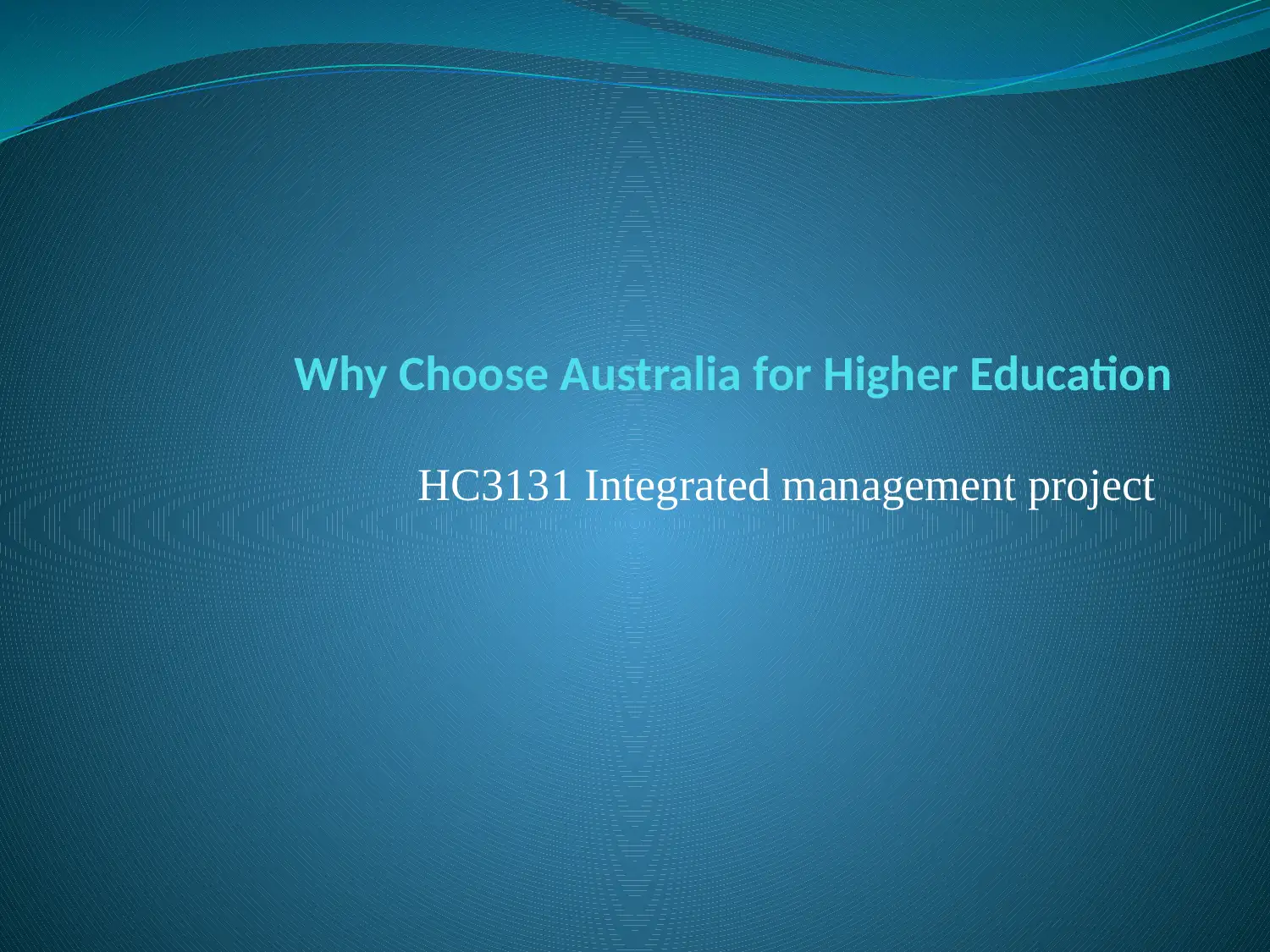
Why Choose Australia for Higher Education
HC3131 Integrated management project
HC3131 Integrated management project
Paraphrase This Document
Need a fresh take? Get an instant paraphrase of this document with our AI Paraphraser
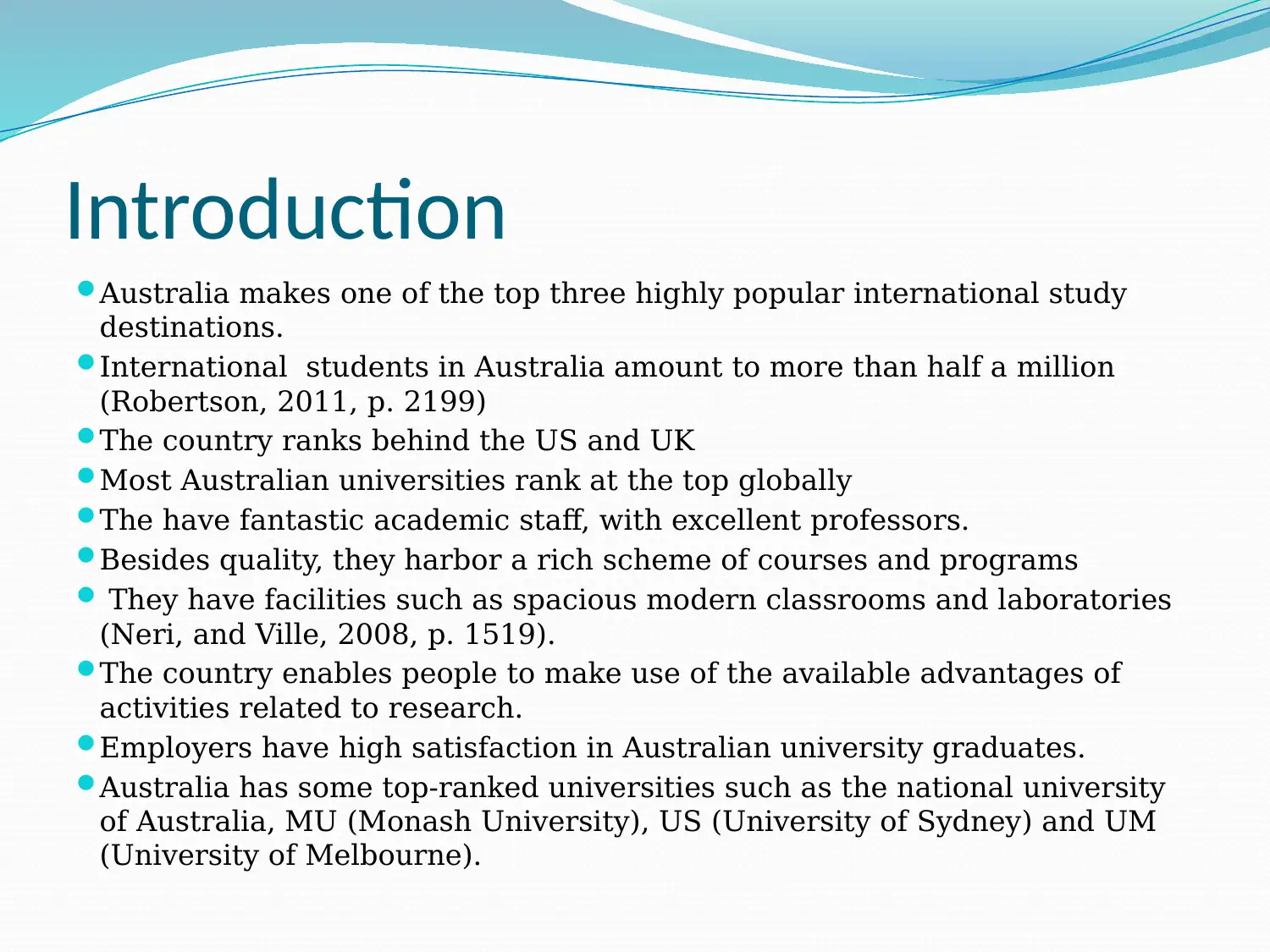
Introduction
Australia makes one of the top three highly popular international study
destinations.
International students in Australia amount to more than half a million
(Robertson, 2011, p. 2199)
The country ranks behind the US and UK
Most Australian universities rank at the top globally
The have fantastic academic staff, with excellent professors.
Besides quality, they harbor a rich scheme of courses and programs
They have facilities such as spacious modern classrooms and laboratories
(Neri, and Ville, 2008, p. 1519).
The country enables people to make use of the available advantages of
activities related to research.
Employers have high satisfaction in Australian university graduates.
Australia has some top-ranked universities such as the national university
of Australia, MU (Monash University), US (University of Sydney) and UM
(University of Melbourne).
Australia makes one of the top three highly popular international study
destinations.
International students in Australia amount to more than half a million
(Robertson, 2011, p. 2199)
The country ranks behind the US and UK
Most Australian universities rank at the top globally
The have fantastic academic staff, with excellent professors.
Besides quality, they harbor a rich scheme of courses and programs
They have facilities such as spacious modern classrooms and laboratories
(Neri, and Ville, 2008, p. 1519).
The country enables people to make use of the available advantages of
activities related to research.
Employers have high satisfaction in Australian university graduates.
Australia has some top-ranked universities such as the national university
of Australia, MU (Monash University), US (University of Sydney) and UM
(University of Melbourne).
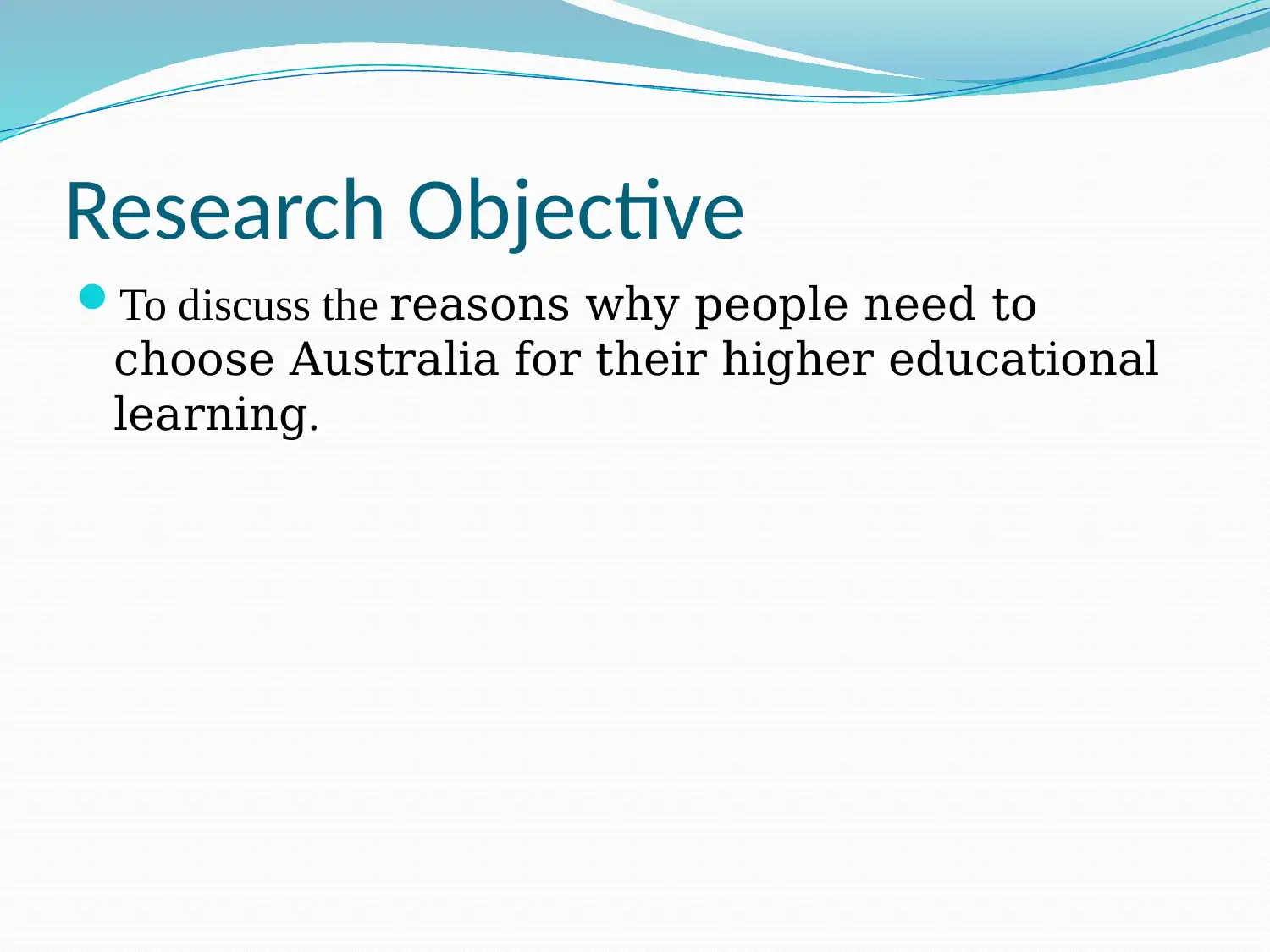
Research Objective
To discuss the reasons why people need to
choose Australia for their higher educational
learning.
To discuss the reasons why people need to
choose Australia for their higher educational
learning.
⊘ This is a preview!⊘
Do you want full access?
Subscribe today to unlock all pages.

Trusted by 1+ million students worldwide
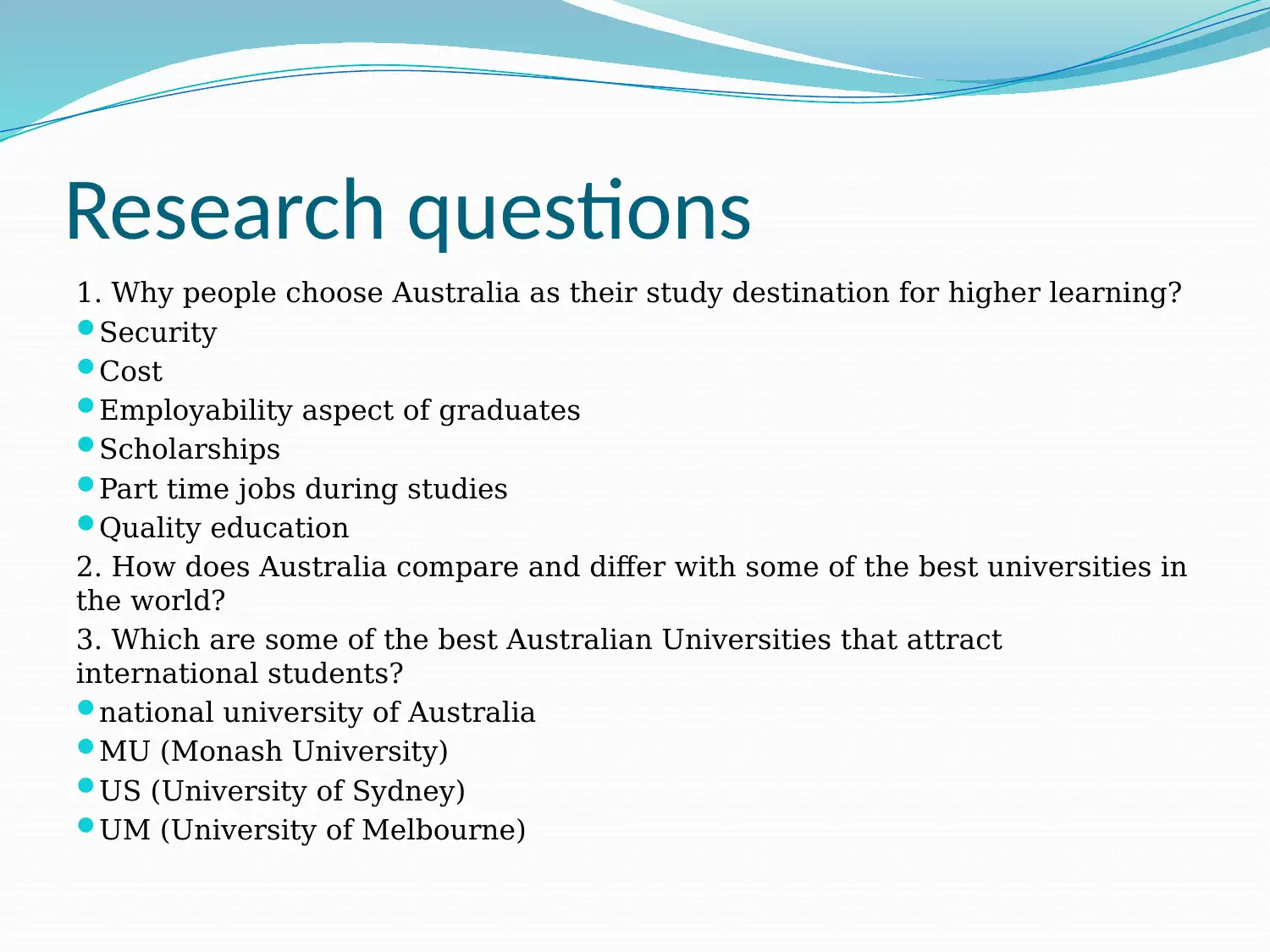
Research questions
1. Why people choose Australia as their study destination for higher learning?
Security
Cost
Employability aspect of graduates
Scholarships
Part time jobs during studies
Quality education
2. How does Australia compare and differ with some of the best universities in
the world?
3. Which are some of the best Australian Universities that attract
international students?
national university of Australia
MU (Monash University)
US (University of Sydney)
UM (University of Melbourne)
1. Why people choose Australia as their study destination for higher learning?
Security
Cost
Employability aspect of graduates
Scholarships
Part time jobs during studies
Quality education
2. How does Australia compare and differ with some of the best universities in
the world?
3. Which are some of the best Australian Universities that attract
international students?
national university of Australia
MU (Monash University)
US (University of Sydney)
UM (University of Melbourne)
Paraphrase This Document
Need a fresh take? Get an instant paraphrase of this document with our AI Paraphraser
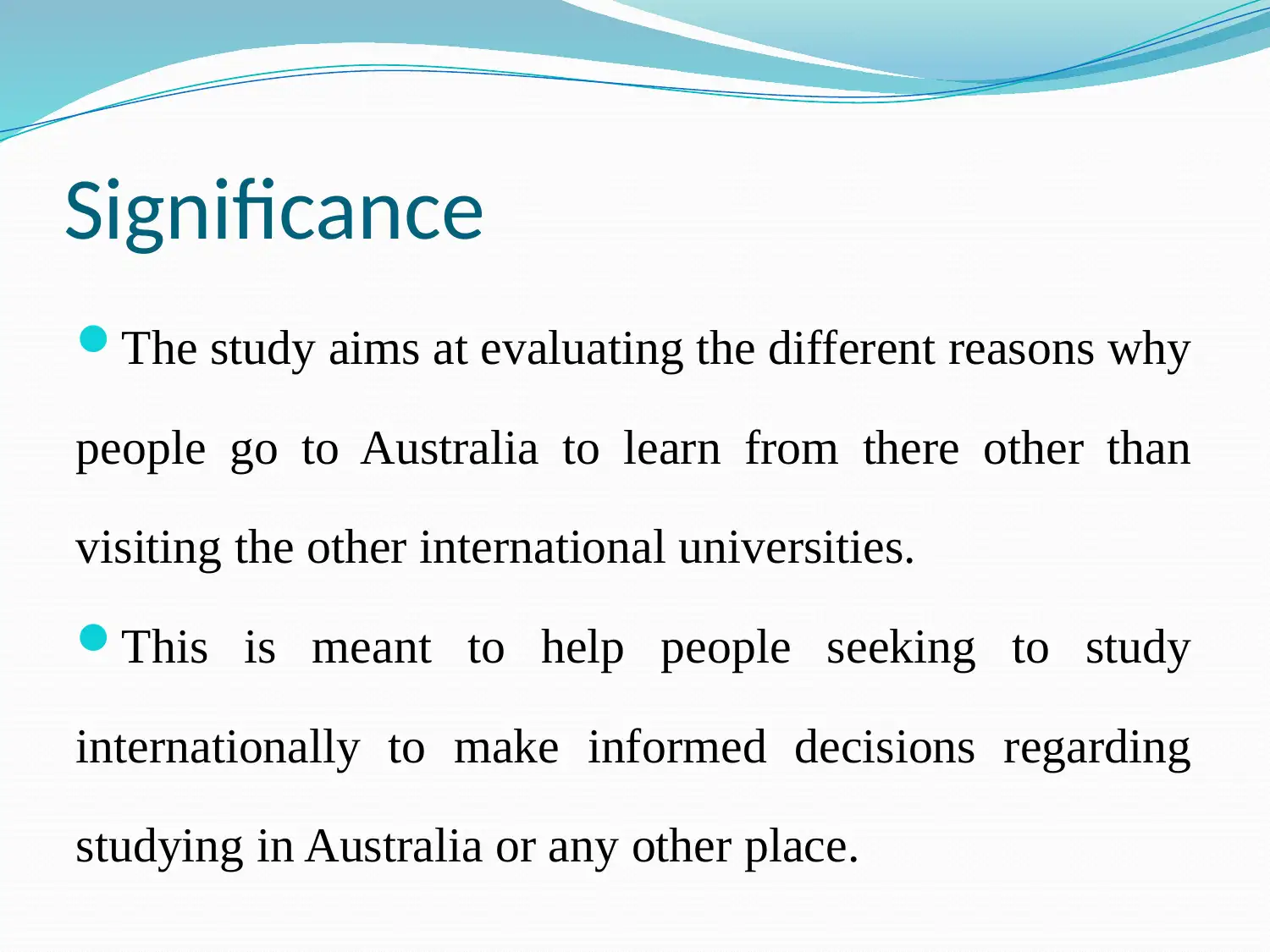
Significance
The study aims at evaluating the different reasons why
people go to Australia to learn from there other than
visiting the other international universities.
This is meant to help people seeking to study
internationally to make informed decisions regarding
studying in Australia or any other place.
The study aims at evaluating the different reasons why
people go to Australia to learn from there other than
visiting the other international universities.
This is meant to help people seeking to study
internationally to make informed decisions regarding
studying in Australia or any other place.
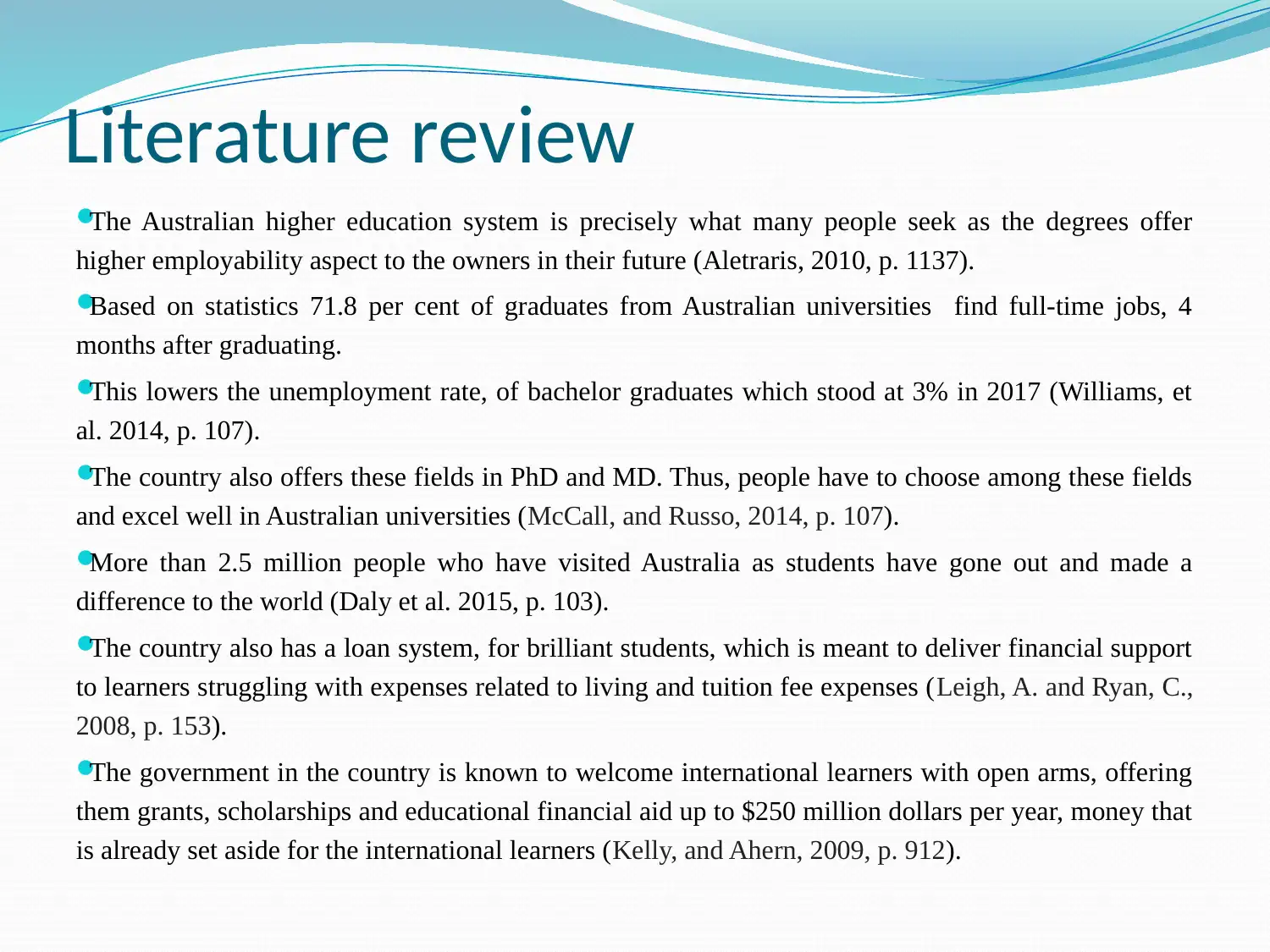
Literature review
The Australian higher education system is precisely what many people seek as the degrees offer
higher employability aspect to the owners in their future (Aletraris, 2010, p. 1137).
Based on statistics 71.8 per cent of graduates from Australian universities find full-time jobs, 4
months after graduating.
This lowers the unemployment rate, of bachelor graduates which stood at 3% in 2017 (Williams, et
al. 2014, p. 107).
The country also offers these fields in PhD and MD. Thus, people have to choose among these fields
and excel well in Australian universities (McCall, and Russo, 2014, p. 107).
More than 2.5 million people who have visited Australia as students have gone out and made a
difference to the world (Daly et al. 2015, p. 103).
The country also has a loan system, for brilliant students, which is meant to deliver financial support
to learners struggling with expenses related to living and tuition fee expenses (Leigh, A. and Ryan, C.,
2008, p. 153).
The government in the country is known to welcome international learners with open arms, offering
them grants, scholarships and educational financial aid up to $250 million dollars per year, money that
is already set aside for the international learners (Kelly, and Ahern, 2009, p. 912).
The Australian higher education system is precisely what many people seek as the degrees offer
higher employability aspect to the owners in their future (Aletraris, 2010, p. 1137).
Based on statistics 71.8 per cent of graduates from Australian universities find full-time jobs, 4
months after graduating.
This lowers the unemployment rate, of bachelor graduates which stood at 3% in 2017 (Williams, et
al. 2014, p. 107).
The country also offers these fields in PhD and MD. Thus, people have to choose among these fields
and excel well in Australian universities (McCall, and Russo, 2014, p. 107).
More than 2.5 million people who have visited Australia as students have gone out and made a
difference to the world (Daly et al. 2015, p. 103).
The country also has a loan system, for brilliant students, which is meant to deliver financial support
to learners struggling with expenses related to living and tuition fee expenses (Leigh, A. and Ryan, C.,
2008, p. 153).
The government in the country is known to welcome international learners with open arms, offering
them grants, scholarships and educational financial aid up to $250 million dollars per year, money that
is already set aside for the international learners (Kelly, and Ahern, 2009, p. 912).
⊘ This is a preview!⊘
Do you want full access?
Subscribe today to unlock all pages.

Trusted by 1+ million students worldwide
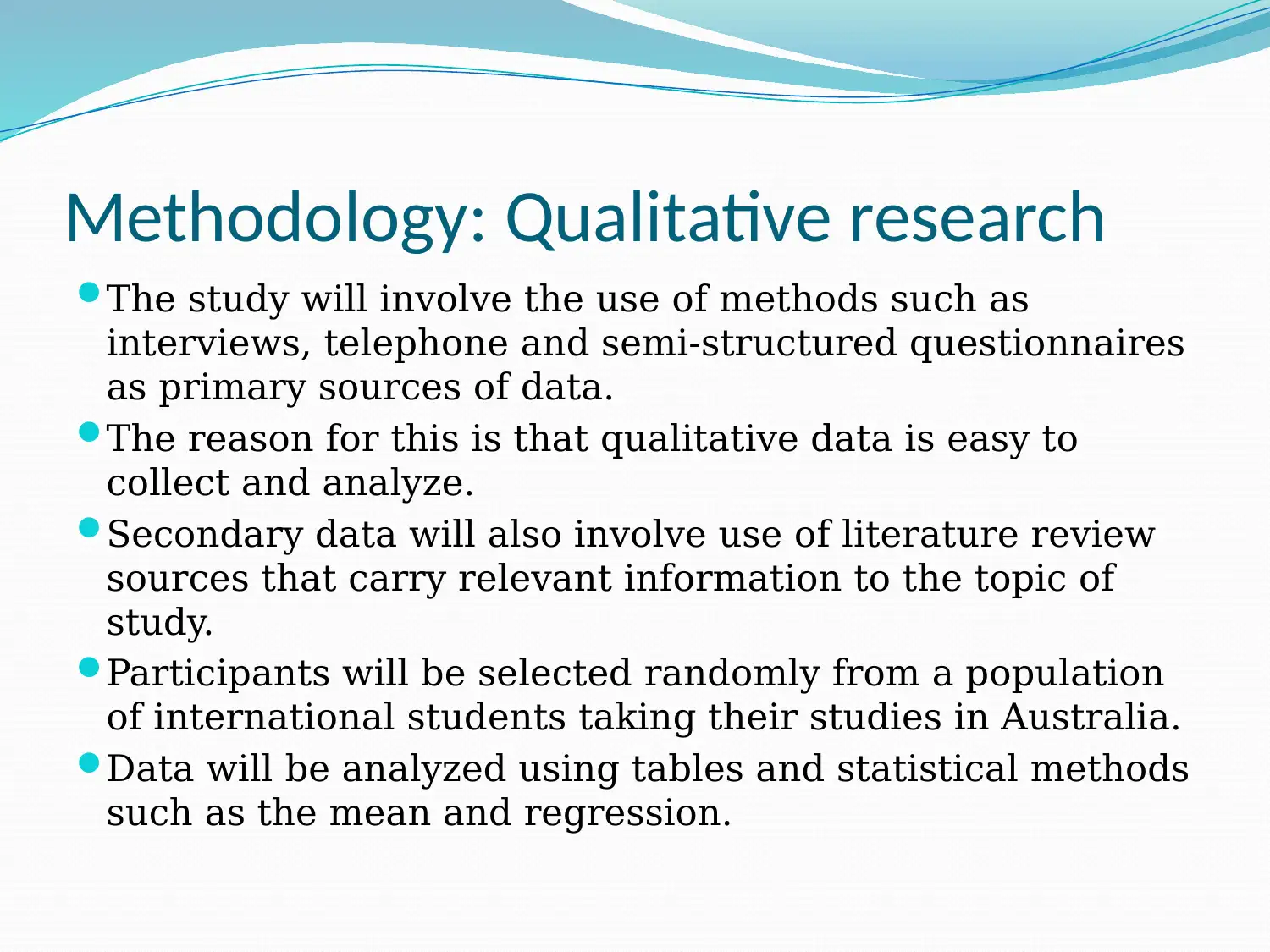
Methodology: Qualitative research
The study will involve the use of methods such as
interviews, telephone and semi-structured questionnaires
as primary sources of data.
The reason for this is that qualitative data is easy to
collect and analyze.
Secondary data will also involve use of literature review
sources that carry relevant information to the topic of
study.
Participants will be selected randomly from a population
of international students taking their studies in Australia.
Data will be analyzed using tables and statistical methods
such as the mean and regression.
The study will involve the use of methods such as
interviews, telephone and semi-structured questionnaires
as primary sources of data.
The reason for this is that qualitative data is easy to
collect and analyze.
Secondary data will also involve use of literature review
sources that carry relevant information to the topic of
study.
Participants will be selected randomly from a population
of international students taking their studies in Australia.
Data will be analyzed using tables and statistical methods
such as the mean and regression.
Paraphrase This Document
Need a fresh take? Get an instant paraphrase of this document with our AI Paraphraser
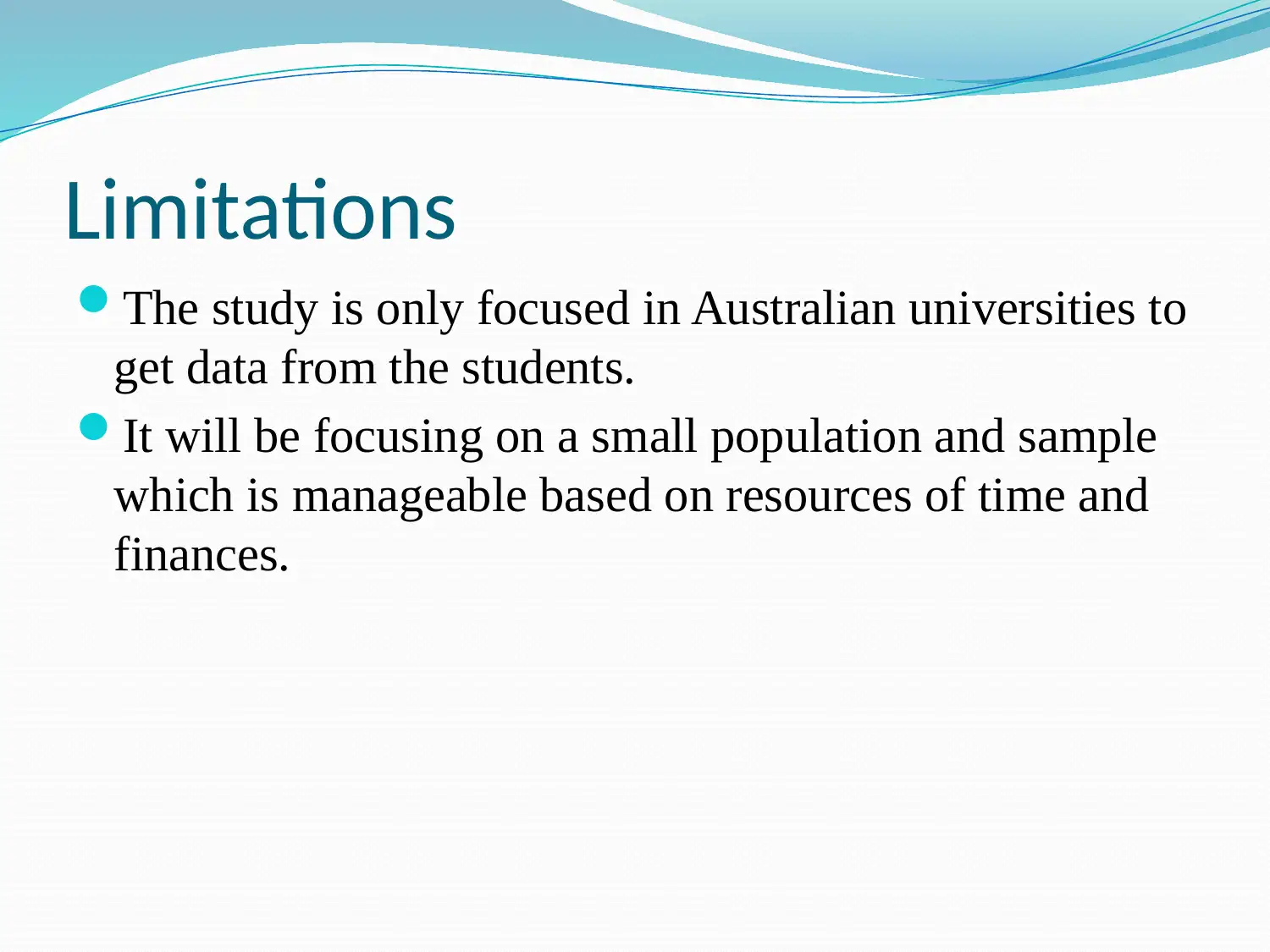
Limitations
The study is only focused in Australian universities to
get data from the students.
It will be focusing on a small population and sample
which is manageable based on resources of time and
finances.
The study is only focused in Australian universities to
get data from the students.
It will be focusing on a small population and sample
which is manageable based on resources of time and
finances.
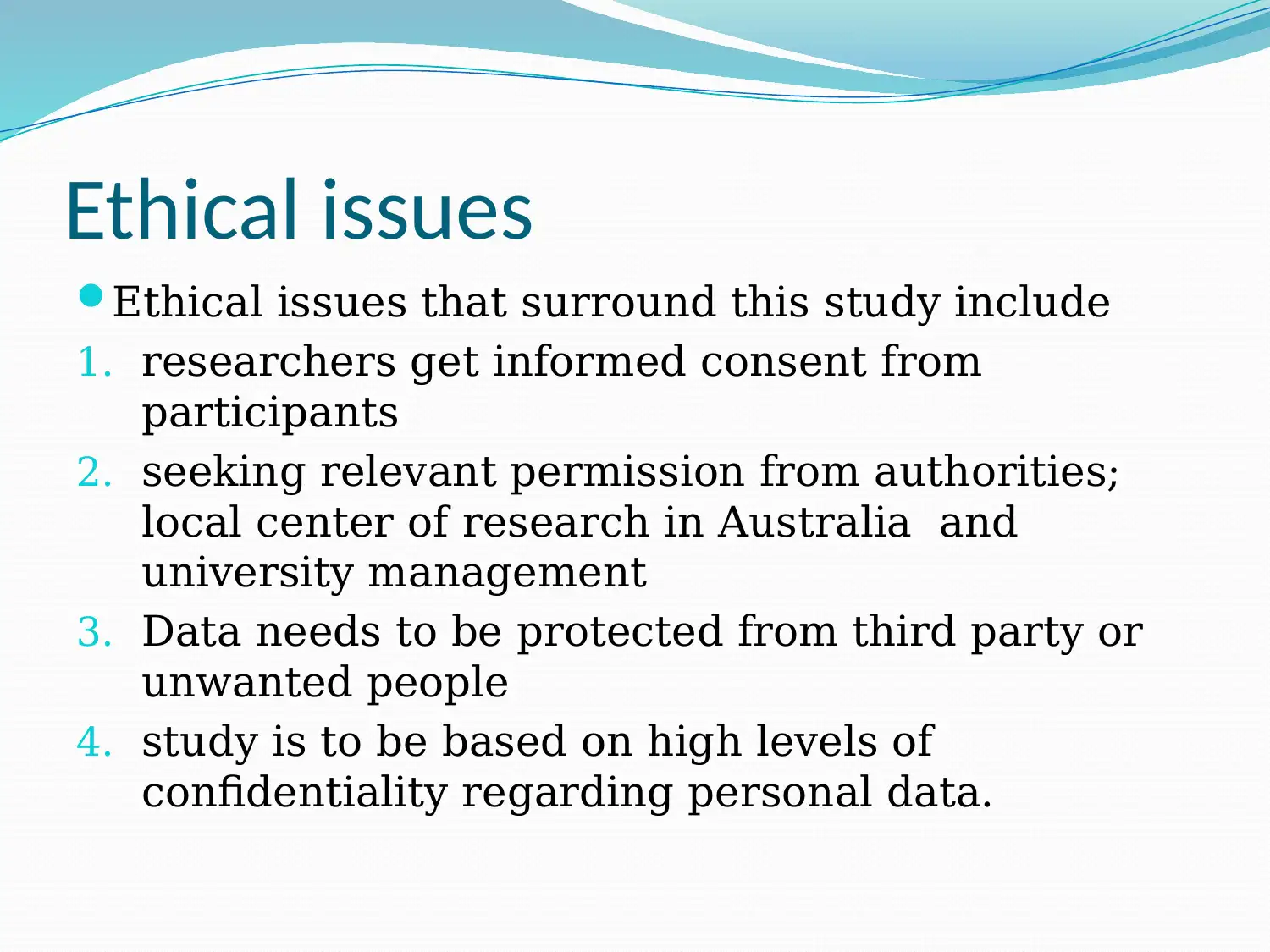
Ethical issues
Ethical issues that surround this study include
1. researchers get informed consent from
participants
2. seeking relevant permission from authorities;
local center of research in Australia and
university management
3. Data needs to be protected from third party or
unwanted people
4. study is to be based on high levels of
confidentiality regarding personal data.
Ethical issues that surround this study include
1. researchers get informed consent from
participants
2. seeking relevant permission from authorities;
local center of research in Australia and
university management
3. Data needs to be protected from third party or
unwanted people
4. study is to be based on high levels of
confidentiality regarding personal data.
⊘ This is a preview!⊘
Do you want full access?
Subscribe today to unlock all pages.

Trusted by 1+ million students worldwide
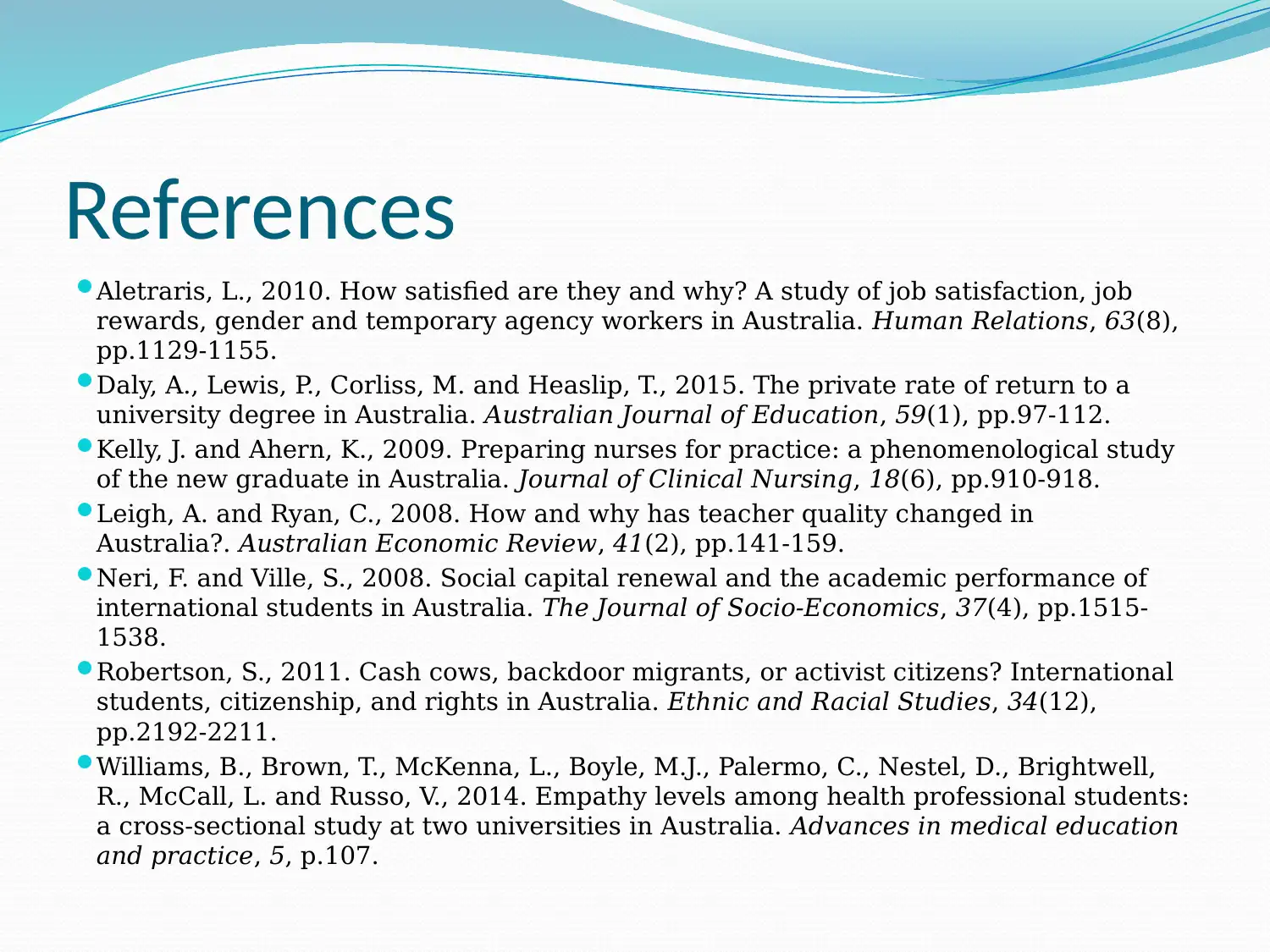
References
Aletraris, L., 2010. How satisfied are they and why? A study of job satisfaction, job
rewards, gender and temporary agency workers in Australia. Human Relations, 63(8),
pp.1129-1155.
Daly, A., Lewis, P., Corliss, M. and Heaslip, T., 2015. The private rate of return to a
university degree in Australia. Australian Journal of Education, 59(1), pp.97-112.
Kelly, J. and Ahern, K., 2009. Preparing nurses for practice: a phenomenological study
of the new graduate in Australia. Journal of Clinical Nursing, 18(6), pp.910-918.
Leigh, A. and Ryan, C., 2008. How and why has teacher quality changed in
Australia?. Australian Economic Review, 41(2), pp.141-159.
Neri, F. and Ville, S., 2008. Social capital renewal and the academic performance of
international students in Australia. The Journal of Socio-Economics, 37(4), pp.1515-
1538.
Robertson, S., 2011. Cash cows, backdoor migrants, or activist citizens? International
students, citizenship, and rights in Australia. Ethnic and Racial Studies, 34(12),
pp.2192-2211.
Williams, B., Brown, T., McKenna, L., Boyle, M.J., Palermo, C., Nestel, D., Brightwell,
R., McCall, L. and Russo, V., 2014. Empathy levels among health professional students:
a cross-sectional study at two universities in Australia. Advances in medical education
and practice, 5, p.107.
Aletraris, L., 2010. How satisfied are they and why? A study of job satisfaction, job
rewards, gender and temporary agency workers in Australia. Human Relations, 63(8),
pp.1129-1155.
Daly, A., Lewis, P., Corliss, M. and Heaslip, T., 2015. The private rate of return to a
university degree in Australia. Australian Journal of Education, 59(1), pp.97-112.
Kelly, J. and Ahern, K., 2009. Preparing nurses for practice: a phenomenological study
of the new graduate in Australia. Journal of Clinical Nursing, 18(6), pp.910-918.
Leigh, A. and Ryan, C., 2008. How and why has teacher quality changed in
Australia?. Australian Economic Review, 41(2), pp.141-159.
Neri, F. and Ville, S., 2008. Social capital renewal and the academic performance of
international students in Australia. The Journal of Socio-Economics, 37(4), pp.1515-
1538.
Robertson, S., 2011. Cash cows, backdoor migrants, or activist citizens? International
students, citizenship, and rights in Australia. Ethnic and Racial Studies, 34(12),
pp.2192-2211.
Williams, B., Brown, T., McKenna, L., Boyle, M.J., Palermo, C., Nestel, D., Brightwell,
R., McCall, L. and Russo, V., 2014. Empathy levels among health professional students:
a cross-sectional study at two universities in Australia. Advances in medical education
and practice, 5, p.107.
1 out of 10
Related Documents
Your All-in-One AI-Powered Toolkit for Academic Success.
+13062052269
info@desklib.com
Available 24*7 on WhatsApp / Email
![[object Object]](/_next/static/media/star-bottom.7253800d.svg)
Unlock your academic potential
Copyright © 2020–2025 A2Z Services. All Rights Reserved. Developed and managed by ZUCOL.





